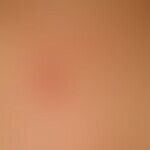Synonym(s)
Granuloma annulare perforans; perforating granuloma annulare
DefinitionThis section has been translated automatically.
Very rare special form of anulare granuloma with central necrosis of the papules and plaques with drainage of a glassy fluid.
EtiopathogenesisThis section has been translated automatically.
Unclear, trauma; late effects of tattoos. Also described after zoster (DD: reactive perforating collagenosis).
You might also be interested in
LocalizationThis section has been translated automatically.
Especially hands.
ClinicThis section has been translated automatically.
0,2-0,5 cm large skin-coloured or red papules with keratotic or crusty surface. In most cases, perforations are less common in the classic type of anular granuloma than in the disseminated (generalized) form. There is a clearly increased association with diabetes mellitus.
TherapyThis section has been translated automatically.
According to the granuloma anulare.
Progression/forecastThis section has been translated automatically.
Inexpensive, often spontaneous healing.
LiteratureThis section has been translated automatically.
- Dornelles SI (2011) Generalized perforating granuloma annulare. To Bras Dermatol 86:327-33
- Fölster-Holst R (2006) Papular and erythrosquamous dermatoses. In: H.Traupe, H. Hamm (eds) Pediatric Dermatology Springer Verlag Heidelberg p.416
- Krahl D et al (1993) Granuloma annulare perforans in herpes zoster scars. J Am Acad Dermatol 29:859-862
- Levi L et al (1986) Granuloma anulare perforans: 2 clinically different forms. Dermatologist 37:23-2
- Madan NK et al (2015) Perforating granuloma annulare in a young male following application of the tattoo. Indian
- Dermatol Online J 6:296-298
- Pereira AR et al (2013) Perforating granuloma annulare mimicking papulonecrotic tuberculid. An Bras Dermatol 88(6 Suppl 1):101-104
Incoming links (3)
Collagenosis reactive perforating; Dermatosis perforating; Elastosis perforans serpiginosa;Disclaimer
Please ask your physician for a reliable diagnosis. This website is only meant as a reference.







